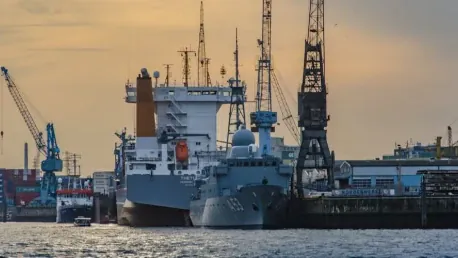China’s ambitious strides in naval development are increasingly evident as the nation progresses toward possessing nuclear-powered propulsion systems for aircraft carriers. This initiative potentially positions China to become the third country globally, following the United States and France, to boast such advanced military capabilities. This crucial advancement was confirmed by researchers from the Middlebury Institute of International Studies in California using satellite imagery and documents sourced from Beijing, revealing a land-based prototype nuclear reactor intended for large surface warships.
Strategic Benefits of Nuclear-Powered Carriers
Extended Deployment Capabilities
Nuclear-powered aircraft carriers provide significant strategic advantages over their conventional counterparts, allowing for extended deployment durations without the need for frequent refueling. This is particularly advantageous in maintaining a continuous naval presence in strategic regions far from home bases. China, with its existing ambitions to project power and influence across vast maritime domains, stands to benefit immensely from such capabilities. Furthermore, the reduced necessity for fuel storage on these carriers frees up valuable space for weapons, aircraft, and other crucial necessities for the crew. This can enhance the overall combat readiness and operational efficiency of the naval fleet.
The ability to generate immense power from nuclear reactors also supports the integration of more advanced technological systems on board. This includes sophisticated radar and communication systems, which are essential for modern naval warfare. Enhanced power generation can also facilitate the use of electromagnetic catapults, a technology that allows for more frequent and efficient launches of aircraft, including heavier and more advanced models. As a result, China’s potential deployment of nuclear-powered carriers could significantly elevate its naval aviation capabilities.
China’s Expanding Naval Fleet
China’s People’s Liberation Army Navy (PLA Navy) already boasts the world’s largest fleet with 234 modern vessels. The addition of nuclear-powered aircraft carriers is set to further enhance its maritime dominance and operational range. This development could pose a formidable challenge to the existing supremacy of the U.S. Navy, particularly in strategically vital regions like the South China Sea and the broader Indo-Pacific. Presently, the United States operates 11 nuclear-powered aircraft carriers, while France has one, with another under construction. In contrast, China’s recent advancements underscore its determination to rapidly close this gap.
One notable example of China’s modern naval capabilities is the Fujian, the latest and largest conventionally powered aircraft carrier. Having successfully completed two sea trials, Fujian features electromagnetic catapults, symbolizing cutting-edge technology shared only with the USS Gerald R. Ford. This technology enhances the frequency of aircraft launches and allows for the deployment of heavier aircraft, thereby increasing the carrier’s operational versatility. These developments illustrate China’s commitment to integrating advanced systems into its naval fleet at a rapid pace, a task facilitated by its efficient shipyards and high production rate.
Implications for Global Naval Power Dynamics
Strategic Challenge to U.S. Naval Superiority
The emergence of Chinese nuclear-powered carriers significantly influences global naval power dynamics. With the continued expansion and modernization of its fleet, China poses an escalating strategic challenge to the traditional naval dominance of the United States. This development has prompted analysts and defense strategists in the U.S. to consider measures necessary for maintaining their edge in maritime capabilities. According to a report by the Center for Strategic and International Studies (CSIS), the United States must prioritize fleet modernization to counter China’s growing naval prowess and preserve its maritime superiority.
The CSIS report underscores the urgent need for the U.S. to invest in next-generation technologies and platforms. This includes the development of more advanced aircraft carriers, surface combatants, and submarines, along with bolstering naval aviation capabilities. Additionally, there is a need for enhanced alliances and partnerships with other nations to collectively deter potential adversarial actions and ensure a balanced power distribution within key strategic regions. The rapid advancement of China’s naval fleet has catalyzed a renewed focus on these areas within U.S. defense policy and strategy circles.
China’s Global Maritime Ambitions
China is making significant headway in naval advancements, particularly in developing nuclear-powered propulsion systems for aircraft carriers. This effort aims to position China as the third nation in the world, after the United States and France, to achieve such sophisticated military technology. Researchers from the Middlebury Institute of International Studies in California have substantiated these claims by analyzing satellite images and related documents from Beijing, uncovering evidence of a land-based prototype nuclear reactor designed for large surface warships. This discovery underscores China’s determination to enhance its naval capabilities on a global scale. Becoming the third country with this technology highlights China’s aspirations to be a dominant player in international waters. This advancement is a significant leap from conventional propulsion systems, providing greater efficiency, speed, and endurance for their naval fleet. The move is part of China’s broader strategy to modernize its military and expand its influence through advanced maritime power.









